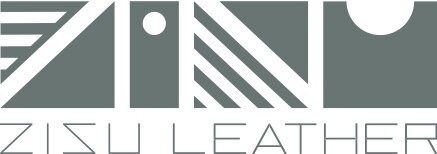leather glossary
ANILINE DYED
Leather that has been thoroughly immersed in a dye-bath but has not received any coating or pigmented finish. This method of transparent dye penetrates the hide with colour.
BELLY WRINKLE
These are the natural wrinkles in the leather’s grain that are a result of a cow's skin stretching. Fat wrinkles are unique to each hide and are typically only visible in full grain leathers. These wrinkles are most common around the neck and shoulder areas of the hide.
BUFFED LEATHER
Leather from which the grain is removed by an abrasive or bladed cylinder. This process is used in altered or corrected grain leather.
CHROME TANNAGE
Leather tanned with chromium salts resulting in soft, mellow hides receptive to excellent color variety.
CORRECTED LEATHER
Sometimes also called enhanced, top grain, snuffed, buffed, or polished leather. Corrected hides have their natural grain sanded off, including all natural characteristics, as well as brands, scars, damaged grain, and wrinkles. Large amounts of pigments, instead of aniline dyes, are then used to cover the new surface of the leather and a heavy embossing is pressed on the pigmented surface to recreate a grain. Corrected hides will not grow old gracefully and develop beautiful unique patinas, like natural leather
DISTRESSED LEATHER
Also known as antiqued leather; leather that is created with a naturally-worn appearance.
DYE LOT
Record taken during the dyeing process to identify product that received its coloration in the same drum/vat at the same time. Manufacturers assign each lot a unique identification number and stamp it on the label before shipping.
EMBOSSED LEATHER
Usually corrected grain, in which a pattern is applied by extreme pressure in a press to give a unique design or imitation of full grain characteristics. Sometimes leathers are embossed to make them appear to be another leather, such as embossing an alligator pattern into cowhide.
FAT WRINKLE
Wrinkles in the grain of leather caused by fat deposits in the animal that create beauty in the leather. Fat wrinkles are not visible in imitation grain leather.
FINISHING
Any process performed after the initial dyeing stage, including buffing, embossing, milling, spraying, etc. Finished leathers are treated with a topcoat substance to help provide abrasion and stain resistance and may also include additional pigments or dyes for coloring.
FULL GRAIN
Natural leather that has not been corrected or altered. Full grain leather possesses its natural, original grain. This gives the leather its character and unique feel.
GRADE
The class of hide determined by its quality.
GRAIN
The distinctive pore and wrinkle pattern that gives the hide its character and feel; may be either natural or embossed.
GRAIN, EMBOSSED
An artificial grain pressed into the surface of top grain leather from which the original grain has been removed.
LIMING
This process includes removal of the hair, preparing the hides for the tanning process.
NAKED LEATHER
Leather that has been tanned and dyed but not had any finishes applied that would alter the natural state of the leather.
NATURAL GRAIN
A leather that retains the full, original grain.
NUBUCK
These are a top grain, aniline dyed leather that have been buffed to create a “suede-like” nap effect.
PATINA
A natural characteristic that develops on full grain leather through normal use over a period of time.
PIGMENTED
Leather that has been sprayed with a pigmented, opaque finish.
PULL-UP
Hide that is waxed or oiled and then pulled to create lighter areas of color.
PURE ANILINE
Leather that has been aniline dyed and exhibits natural markings and characteristics as its grain has not received any alterations.
SAUVAGE
The resulting marbled appearance created by blending two or more similar colors on a hide.
SEMI-ANILINE LEATHER
Leathers that have been aniline-dyed then top-coated with matching pigments to even out the color (also called aniline plus).
SKIVE
To slice or split into a thin layer, or to reduce leather to a specific thickness.
SPLITTING
The second layer or center cut of a hide that is uses to make suede.
SUEDE
Leather produced from the lower skin split of a hide, thus possessing a velvet like nap effect. Suedes do not have the same durable characteristics as top grain leathers.
TANNIN
Any various solvent, astringent substances of plant origin used in tanning leather.
TOP GRAIN
Leather produced from the top portion of the skin split. Top grain can be either full grain or embossed grain and produce a stronger, more flexible hide.
UNFINISHED LEATHER
Normally defines aniline dyed, naked leathers with no additional application intended to finish, color or treat in any way that would alter the natural characteristics of the leather.
